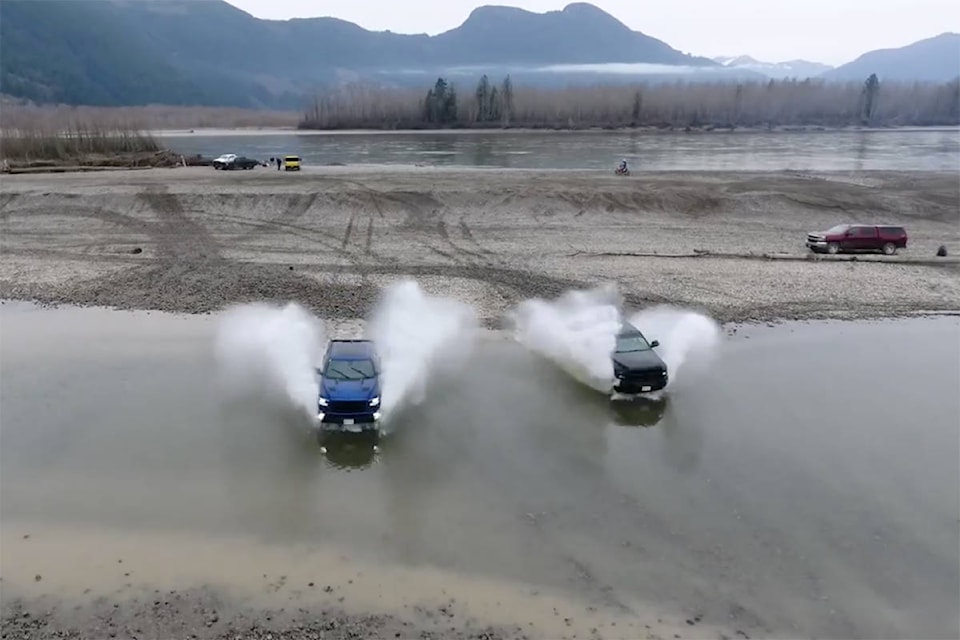Off-roading can damage fish and sensitive fish habitat on the banks of the Fraser River near Chilliwack.
That’s the essence of a new awareness campaign launched by Fisheries and Oceans Canada (DFO) after video recently surfaced of pickup trucks churning through Fraser side channels at Gill Road bar.
“We’ve got a file open and it’s an active investigation,” confirmed fishery officer Mike Fraser, detachment commander for DFO Fraser East, about the video. “The enforcement options range from education and stewardship, through to warnings, right up to charges and fines.”
Education is first. New signage is coming to the popular riverside spot in Chilliwack known as Gill bar to stave off further habitat destruction.
A public notice from DFO by the stream will warn: “Use of ATVs in fish habitat is prohibited,” and then it clearly defines what fish habitat is.
“This stream supports a variety of salmon and trout and is fish habitat,” it reads.
The video that got everyone talking in the first place features a convoy of trucks repeatedly crossing through a side channel of the Fraser River to the tune of country trap artist Breland and his breakout song, My Truck. The video, since removed, provoked outrage among river stewards and conservationists who issued calls for enforcement by DFO.
“Any time you have an area like this with sensitive habitat, and the sheer volume of increased use, coupled with a lack of awareness and education, that is when we start to see impacts,” the fishery officer said.
New signage will remind off-roaders whether it’s trucks, quads, or dirt bikes to avoid mudflats, estuary lands, wetlands, rivers and streams.
Mark Angelo, the founder of World Rivers Day, and Rivers Chair of the Outdoor Recreation Council, said he was “disheartened” when he saw the video of trucks driving through the river.
“I knew there were salmon eggs in the gravel – so fish were killed and spawning beds were damaged,” Angelo told The Progress. “In terms of what can be done to better protect this amazing area, there are a number of things that can be undertaken.”
Angelo pointed out that the Heart of the Fraser, the stretch between Hope and Mission “is one of the most productive and spectacular stretches of river on the planet.”
The plan is to lobby federal representatives to list the area as an “ecologically significant area” (ESA) a new designation created under the Fisheries Act.
“This is a new listing under the Act that has yet to be used, but there is no better initial candidate in the country than the Heart of the Fraser,” Angelo argued.
At the very least it’s a more “precautionary approach to management” and he believes it would further strengthen the push to develop a much more thorough conservation strategy/management plan for the area. In terms of immediate steps for the area around Gill Bar, DFO should be doing “much more” on the enforcement end.
“Trucks simply shouldn’t be driving in the river,” Angelo added. “Local governments could better manage access, and there’s also a very real need for appropriate signage around the site.”
The new signage will remind users that every stream counts.
“A single stream or estuary may appear insignificant as a producer of wild fish, but when combined with the thousands of other small estuaries and streams in B.C., they account for a large amount of fish production,” the sign will say.
Vehicles driving through sensitive aquatic environments can “erode stream banks, increase sediment, smother incubating fish eggs, destroy estuary marches, grasses and streamside green areas.”
Vehicles can also leak pollutants, such as oil or gas into sensitive habitat.
To report violations of the Fisheries Act, there is the ORR line, Observe Record and Report any fisheries violations at 1-800-465-4336.
Protection of habitat is found under the federal Fisheries Act Section 35(1) which states that “no person shall carry on any work, undertaking or activity that results in the harmful alteration, disruption or destruction of fish habitat.” But there are also relevant sections under the Species at Risk Act, Criminal Code, B.C. Wildlife Act or B.C. Forest and Range Practices Act.
